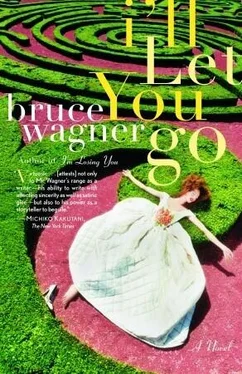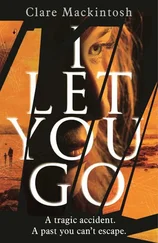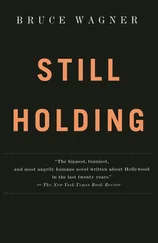Like most on board, Tull slept the entire flight back to California, with nary a ghost of present, past or future to invade unconsciousness.
Settling into the comfort of their respective homes, the youngest Trotters kept to themselves for a full week, hardly even speaking on the telephone — though, with usual aplomb, Edward sprang back in record time, the only toll paid for his resilience being a harsh and intractable case of acne.
Tull was slower to surface. He was glad to see Pullman again, but the dream had sorely spooked him; it was a while before he dared take his old friend on a constitutional in the sealed park, fearing what they might find.
†Something must be aired, if a bit prematurely. A question may arise: Why, or how, could such an impossible array of peculiar places be visited in so short a time? An eclectica of destinations was culled from the exotic wish list that Lucy and her brother had whimsically drawn up; their father was committed to fulfilling those wishes to the letter. The logistics were a challenge, but it would get done. There is no limit to wealth and its imaginative excesses, just as there is no limit to the proscriptions of poverty — but the details of both extremes are sometimes difficult to comprehend. Just as a sixty-year-old woman might spend three days knee-deep in recycling bins so she might gather the capital to buy her grandson shoes, so may a father fly a chef from Hong Kong to Palos Verdes with ten $20,000 boxes of saliva-thread swallows’ nests to make special soup for his daughter’s bat mitzvah. Such is the world.
†It should be noted that the Trussardis were $5,000 apiece, retail. Well, whether it should be noted or not, the author begs indulgence for his catalogue des excès and would argue it to be something more; that such details are relevant to this chapter and of legitimate ethnographic interest. In this vein, he will add that the eager students were cautioned to steer clear of Gothick Hall, which harbored a secretary built by Rhode Island cabinetmaker Christopher Townsend, its silver fixtures smithyed by one Samuel Casey, and recently acquired by Lord Went at Sotheby’s for the not unlordly sum of £7 million. Nor were they to approach the $210,000 bottle of Château d’Yquem, personally engraved with Thomas Jefferson’s initials — though grown-ups were allowed to have a look if not a taste. The good lord also happened to be a collector of money itself . As a hobby, he enjoyed buying uncirculated legal tender: $500, $1,000, $5,000 and $10,000 bills (he’d purchased one of the latter for around $115,000), whose value increased exponentially each year.
†Against all intentions, the Keatons did not make it that far. Young Dexter’s earache precluded her flying; the two graciously took their leave in Tel Aviv, and were much missed to journey’s end.
CHAPTER 27. For the Child Who Is Not Present
“I want everyone to look for the mosasaur, OK?”
The teenage docent held a shark fin in his hand. The children reached out carefully, as if the fossil might still cause mayhem.
“And when you find the mosasaur — you’ll see how really huge it is — when you find the mosasaur, just remember: this very huge creature was eaten by the much smaller shark .”
He stroked the hooked piece of cartilage to emphasize its role as David to the mosasaur’s Goliath. Then he held it in front of Amaryllis, cuing her to touch. She wouldn’t, a fact not lost on Dézhiree. The fin wound up at the wheelchair, in Cindra’s lap; the disabled girl squirmed and rolled her eyes in delight.
There were two MacLaren field trips that summer — the mosasaur having been encountered on a sweaty, bus-rattled fiesta to Exposition Park’s stately Natural History Museum. Though nearly ruined, the coliseum abutting that place was far from Rome; a newly minted IMAX behemoth had infected adjacent buildings with its garish pastels and multiplex aesthetic. “Dancing Waters,” those cheap public-space ejaculations that soak the kids during parental cigarette breaks, added to the sprucing up — all this part of the rankly meretricious, cheesily stimulating great American playground, arty and self-aggrandizing, thrilled with itself no end. The whole chain-linked grid, surrounded by a flatland of jaundiced soccer-trodden crabgrass, was supposed to be a free-spirited architectural tribute to the putative joys of Science and Learning yet was in fact an ugly hodgepodge of loading zones and dented dumpsters that no one, not even the brightest design intern, had thought to conceal from general view. But the children of MacLaren weren’t critics — they were just happy to be in the “outs,” roaming the cool halls of glassed-in bison and saber-tooth. The dioramas were as calming as meds.
In the three months since Amaryllis became a Pixie, she had been taken to children’s court on the occasions that her stay at Mac exceeded the amount of time prescribed by law; in those same three months, two suitable placements had been found that were quickly deemed otherwise (though not at all in the league of the perilous Canyon klatch of E. Woolery).
For example, on the weekend of her arrival at the well-kept, super-stuccoed home of the Barnard Tofflers of Rosemead, she was sent packing due to an allergic reaction to the family cat — severe enough to require a trip to the emergency room at the ungodly hour such trips typically demand. Rosemead was not big enough for both of them, but Mrs. Toffler would not part with her beloved. This standoff, coupled with the girl’s habitual under-sheet flashlight explorations of the machinery of martyrdom, had the effect of making the whippet-size, already skittish Mrs. Toffler more skittish still. After a day or so of relative segregation from the pet, Amaryllis was remanded to Mac. To be fair, the Tofflers bought her a dress in consolation.
In the second instance, she remained with the Alfredo Quiñoneses of Diamond Bar for a relatively carefree three weeks. The rural home had a big backyard with swings, barbecue and aboveground pool. Besides Amaryllis, five children lived there, all told; two were “real” Quiñoneses, while three were adopted (a palsied one among the latter, the disabled being a sacrosanct — and lucrative — cliché of Adoption World). A few weekends in, before school began, the mellow Mr. Quiñones, aged fifty, had a coronary and died. Soon after, a wet-eyed Quiñones aunt dutifully returned Amaryllis to MacLaren, along with Palsy Girl, who barked and wept the whole ride back.
Yet the vicissitudes of an adoptee’s life were nothing compared to Amaryllis’s wrenching separation from the babies. Their initial reunion was short-lived; knowing the inevitable, the Mac staff was more lenient than usual in providing the star-crossed family with “together time.” (Only once did Saffron ask where her mother was. “Heaven,” said Amaryllis, and her sister seemed satisfied. When she inquired if it would be possible to visit that place for a picnic, Amaryllis wished her nominated to the Congregation for the Causes right then.) The age and adorableness of the babies made them “bull’s-eyes”: within five days of their arrival at the center, they were placed in a private home. Amaryllis dehydrated herself with tears. Lani Mott showed up to reassure that “family lawful visits” would be arranged — as the girl’s official CASA (the court paperwork had just gone through), the baker’s wife informed that she was “launching a third world war” to find a single placement for the three siblings so they could remain together. Everyone knew the chances of that were almost nil. But each time Amaryllis returned to Mac, she futilely asked for her Saffron and Cody, awaiting word that never came. No one would tell her where they were; she couldn’t even call them on the phone.
Читать дальше












